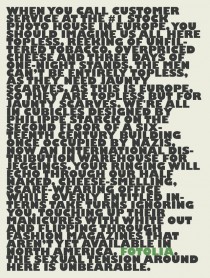In the world of advertising, there is a constant battle for attention. Marketers employ various creative techniques to stand out in a crowded space where visual elements often dominate. However, every now and then, a bold move emerges that challenges conventional wisdom. Fotolia’s decision to run a text-only ad is one such remarkable instance. In this article, we delve into the details of Fotolia’s bold move and explore the power of a text-only advertisement in today’s advertising landscape.
The Evolution of Advertising
Advertising has come a long way from the early days of simple, text-based newspaper ads. In the digital age, visual content, multimedia, and interactive experiences have dominated advertising. As a result, text-only advertisements have become a rarity, and many marketers consider them outdated and less effective. However, Fotolia’s recent foray into text-only advertising challenges this notion.
Fotolia’s Approach
Fotolia, a well-known stock photography and visual content platform, has been synonymous with stunning visuals for years. Nevertheless, they decided to take a different route for one of their recent ad campaigns. Instead of relying on captivating images, they opted for a purely text-based approach.
The Ad Content
The ad in question is a simple yet striking text message: “A picture is worth a thousand words, but the right word is worth a thousand pictures.” The statement succinctly captures the essence of Fotolia’s services and the value they provide to their customers.
Why This is Bold
- Counterintuitive: In an age where visuals dominate, Fotolia’s decision to use only text goes against the grain. It’s a brave choice that defies conventional advertising norms.
- Captures Attention: The simplicity of the text-only ad stands out amidst the visual clutter that saturates the advertising space. In doing so, it effectively captures the viewer’s attention.
- Engages Imagination: By prompting the reader to consider the power of words over images, the ad engages the audience’s imagination. It invites them to reflect on the message and its relevance in their own lives.
- Brand Reinforcement: While the ad is text-based, it still reinforces Fotolia’s brand identity as a provider of valuable visual content. It cleverly suggests that while words are powerful, images are essential, and Fotolia has a vast repository of them.
- Simplicity and Clarity: Text-only ads are inherently clear and straightforward, ensuring that the message is easily comprehensible. This is especially important in a world where information overload often leads to shortened attention spans.
The Impact
Fotolia’s text-only ad has generated considerable buzz and discussion in the advertising and marketing communities. It has been widely shared on social media platforms, further extending its reach and impact. Additionally, it has sparked a renewed interest in the potential of text-based advertising in a world obsessed with visuals.
The Power of Words
Fotolia’s bold move underscores the enduring power of words in the advertising landscape. While visuals can be captivating, words have the unique ability to convey complex ideas, evoke emotions, and spark imagination. Text-only ads can be an effective means of delivering a message in a direct and uncluttered manner.
Conclusion
Fotolia’s decision to run a text-only ad is a testament to the brand’s innovation and willingness to challenge the status quo. In a world where visual content often reigns supreme, this move serves as a reminder that words have their place and can be used effectively in advertising.
While text-only ads may not replace visual advertisements, they certainly offer a compelling alternative. They can capture attention, engage the imagination, and deliver a clear and impactful message. In the end, Fotolia’s bold move highlights the enduring power of words in an increasingly visual world.

